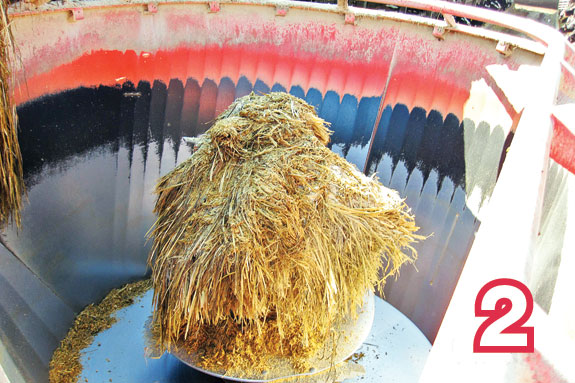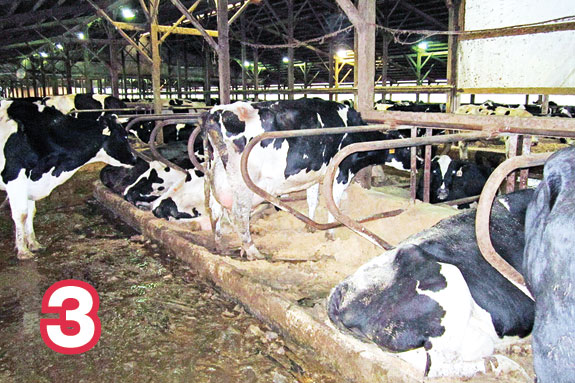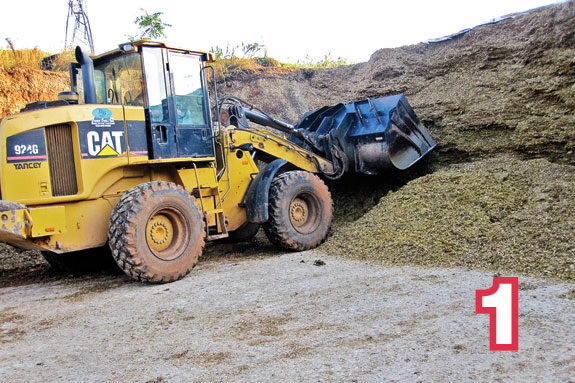When a 1,150-cow dairy asked for a TMR audit, we welcomed the opportunity to work with this well-run operation to help it gain ever greater production efficiencies. Even well-run dairies often have opportunities that an outsider can see more easily than someone immersed in the dairy’s daily management.
The audit was requested for two reasons: First, the dairy’s total mixed ration (TMR) was thought to contain excessive particle size; second, the owner and herdsman wanted an evaluation of the feeding system’s efficiency and timing.
The management team knew they faced some challenges. They also knew many things were being done right, as the 900 lactating cows averaged 74 lbs of milk per cow per day, even with all the heat and humidity of the Southeast.
We began by discussing how variation in the TMR can cause inconsistency in the cows’ performance. For cows to achieve maximum productivity, ration variations must be minimized.
Ideally, no variations whatsoever should exist, but that’s virtually impossible. The management team confirmed that they were open to making changes as needed for the operation to progress.
Discovery
Next, we did a walk-through to assess areas of concern. The TMR showed significant sorting. Excessive particle size allowed a large portion of the small-grain baleage to be sorted. While the cows appeared healthy, their manure contained some inconsistency, which could be due to the sorting.
The cows also seemed dirtier than desired. They were comfortable in their stalls but were positioned too far forward. A considerable amount of urine and fecal material was accumulating in the back of the stalls.
This was interesting in light of the fact that the owner had expressed concern about keeping somatic cell count (SCCs) under control. We recorded this finding to review at the end of the audit.
At the bunker silo, the silo face was not as smooth as it should be, which increases the risk for extra heating of the silage.
Equipment was in good repair because it was relatively new. Regular maintenance was the feeder’s responsibility but was not being recorded.
The mixing consistency of each load and the consistency among loads were examined, along with the efficiency of the mixing procedure.
The loads showed variation in particle size – even though the feeder proved to be consistent in his mixing and loading.
As we looked deeper, I noticed one of the screws in the vertical mixer was covered with baleage. During the round bale processing, the forage had become twisted around the top of the screw and was preventing the proper mixing of the TMR. I asked to have a round bale processed in hopes I could see why this was happening.

The herd was being fed two bales per day with each bale processed separately. Loose, unprocessed forage would collect on the screw.
When two bales were processed together, though, the baleage was cut into a more desirable particle length and in half the time. The reduced particle size made the TMR much more consistent.
We also saw that the bucket of the loader was being used to face the bunker silo.
While the feeder certainly did a conscientious job, the face was rough. Instead of facing the entire bunker, the feeder was pulling some silage down and scooping it into the mixer.
As a result, different layers of silage could be seen from top to bottom. This was creating variation among loads: Each load contained silage from different layers. Consistency was lacking.
I suggested facing the entire bunker then pushing it into one pile to pre-blend the silage before putting the blended silage in the mixer as well as possibly using a bunk defacer. The owner has since implemented this suggestion.
Finally, we discussed the SCC. Receiving the quality premium is very important, especially in times of depressed milk prices. The owner wanted to strive for the monthly premium. We agreed to conduct a milk quality audit and set a time to return.
Results
Making the recommended changes did not require a lot of capital expenditures. Other than the purchase of the silage facer, the recommendations consisted of changes in management and working procedures.
The dairy has benefitted substantially from the TMR audit. Milk production increased approximately 3 pounds per cow per day, generating an additional $29,000 monthly for the herd. Along with the milk increase, total dry matter intake (DMI) decreased by 2.3 pounds per cow.
Feed efficiency improved by 11 percent for another $22,000 per month in savings. Daily DMI fluctuation decreased from 6.07 pounds per head for the previous 45 days to 3.94 pounds per head for the 45 days following the TMR audit. The herd size, days in milk and ration were constant through the changes.
These changes took place during some of summer’s hottest months. Providing a consistent diet with minimal variation is a critical component of superior nutrition for high production. It is as important as having a well-formulated diet.
Milk quality audit

Later on this same dairy, our team conducted a milk quality audit.
The audit led to the recommendation that cows be positioned differently in the stalls by moving the neck rail on the stall backward and adding more sand.
The herd’s milk production increased again by approximately 3.6 lbs of milk to approximately 81 lbs of milk per cow per day.
The SCC decreased more than 22,000 cells per milliliter. The herd now consistently qualifies for the milk quality premium bonus. The bonus added $21,000 of income per month.
The owner had mentioned that managing a large commercial dairy efficiently is a constant battle. I asked if he kept written protocols and procedures for everything on the farm. He indicated most were shared verbally but weren’t in writing.
Our recommendations are that each procedure and protocol should have someone who is accountable for making sure it is observed and followed through on.
In addition, the procedures and protocols need to be written down and discussed with all involved. When they are not in writing, it can be hard to hold someone accountable.
I challenged the management team to establish or review the written procedures for the feeder, maintenance of feeding equipment, maintenance of milking equipment and the milking process – and to sit down with all individuals involved to discuss the importance of the written procedures and protocols.
If problems arise, written procedures and protocols help the manager to narrow the area of focus for the solution.
Summary
Because our TMR audit includes a comprehensive look at all areas of the dairy operation, we were able to help the dairy improve ration consistency, decrease SCC and move toward having written procedures and protocols, which will ultimately maximize the operation’s profitability. PD
Greene is a dairy field technical specialist with Diamond V who serves the eastern U.S.
PHOTOS
TOP RIGHT: Facing the bunker silo with the loader bucket was creating layers of silage and causing TMR inconsistencies.
MIDDLE RIGHT: One of the screws in the mixer wagon was covered in baleage and was preventing proper mixing of the TMR.
BOTTOM RIGHT: The cows were comfortable in their stalls but had been positioned too far forward. With this now corrected, urine and fecal material no longer accumulate in the back of the stalls. Photos courtesy of David Greene.






